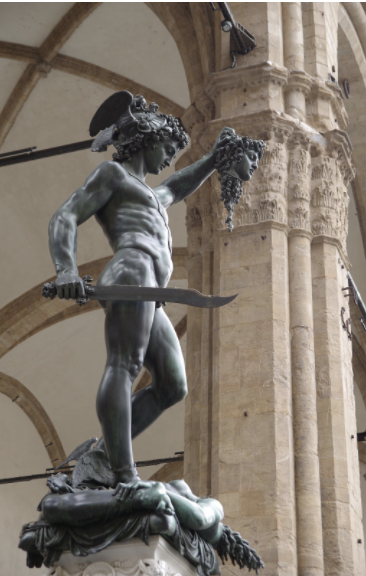“In Her Eyes”: La Medusa by Versace and the Reframing of the Original Nasty Woman
Graphic by Agnes Lee.
*Trigger warning: this article includes mentions of rape
In a promotional video for “La Medusa”, Versace’s new leather handbag adorned with the company’s iconic logo, Hailey Bieber lies in the underwater cove of Versacepolis. Bieber is surrounded by references to Greek antiquity — elaborate stone columns, a statue of a man carved in Greco-Roman style, and a large stone slab bearing Medusa’s likeness. She lies in the sand in the middle of this scene, reaching for a brightly colored version of “La Medusa” as it floats out of her reach.
The “La Medusa” handbag line premiered at Versace SS21, where it was carried down the aisle by Hailey Bieber, Kendall Jenner, Mona Tougaard and Precious Lee. In these models, Donatella Versace sought to portray modern women who view Medusa as their muse.
“[I wanted to] highlight how her many faces can be drastically different from one another, and every woman can actually be Medusa,” Donatella Versace said in an official statement. “All of us, with our differences and unique characters, we can express ourselves also in the way we decide to dress.”
Kendall Jenner (left), Precious Lee (center) and Hailey Bieber (right) with “La Medusa”; Image via Grazia
Medusa has been the Versace logo since 1993. The story goes that Gianni Versace first came across the Gorgon’s image while he was growing up in the southern Italian town of Reggio di Calabria. Gianni and his sister, Donatella, used to play in the ancient ruins surrounding their home, where they spotted a tiled motif of Medusa on the wall. After Gianni grew up and started his own clothing line, he recalled the powerful image of Medusa from his childhood and decided to use her as the face of his company.
“When I asked Gianni why he chose Medusa’s head,” Donatella Versace once explained, “he told me he thought that whoever falls in love with Medusa can’t flee from her.”
This year, Versace’s new handbag line brings Medusa’s story back into the spotlight. What does she signify? And in what ways has popular culture done her an injustice?
Medusa’s Story
When most people think of Medusa, they conjure up images of the writhing snakes that coil atop her head and her ability to turn mortals to stone with just a glance. They may recall how Medusa became a monster: she slept with Poseidon within Athena’s temple, and the goddess, who was Poseidon’s lover, cursed her in retaliation. When Medusa started wreaking havoc on the mortal population, Perseus killed her and brought her head to Athena to mount on her shield.
However, if we return to the roots of the myth, a very different picture emerges.
Ovid was the first person to tell Medusa’s story in Metamorphoses. In the original myth, Medusa started off as a young maiden, one of three sisters called the Gorgons. Her life changed when she entered Athena’s temple and was raped by Poseidon. Athena assumed that Medusa was the instigator of the sexual encounter and cursed her for the rest of time.
The Ancient Greeks and Romans understood that despite Medusa’s outward appearance and her ability to turn men to stone, she wasn’t actually evil. Art from this time period often depict Medusa smiling or otherwise with a neutral countenance rather than the grotesque monster that she’s portrayed as nowadays.
Terracotta roundel of Medusa circa 2nd century BC; Image viaThe Metropolitan Museum of Art
Medusa vase created 4th-3rd century BC; Image via the Metropolitan Museum of Art
“Perseus With the Head of Medusa”; Image via Wikipedia
Depictions of Medusa shifted in 1554, when Benvenuto Cellini forged the sculpture “Perseus with the Head of Medusa, depicting Perseus brandishing Medusa’s severed head as he stands over the Gorgon’s dead body. This statue was incredibly popular and reframed Medusa’s narrative in a way that made her appear like a threat to be conquered.
One could argue that when Medusa turned men to stone, she was reclaiming the power that she lost when she was sexually assaulted. But Cellini’s sculpture denied her this right and transformed her narrative into the ghastly one that often permeates popular culture today.
In recent years, conversations about Medusa started shifting again for the better. During the United States’ second wave of feminism, from the 1960s to the 1980s, feminists like Hélène Cixous, Sylvia Plath and Colleen McElroy channeled Medusa to engage in discourse about the silencing of sexual assault victims. In addition, the feminist scholar Marija Gimbutas re-read Medusa’s story so that it reflected the death of early matriarchal societies in Ancient Greece and Rome. An article from the Atlantic calls this an attempt to “legitimize male privilege by muting female authority.”
In 2008, Luciano Garbati challenged Cellini’s sculpture by creating his own artwork that reframed the narrative yet again: “Medusa with the Head of Perseus.” Last year, New York photographer Bek Anderson spearheaded efforts to install Garbati’s work across the street from the Manhattan court where Harvey Weinstein stood trial, making Medusa a symbol of the #MeToo movement.
Image via Suffrage Forward
And this year, Donatella Versace’s statement on the significance of “La Medusa” rings true.
“All of us, with our differences and unique characters, we can express ourselves also in the way we decide to dress,” she said.
Perhaps Donatella didn’t intend for this exact meaning, but I believe “La Medusa” allows women to reclaim power in the same way that Medusa armed herself with the snakes on her head and her newfound ability to petrify with a single glance. By featuring loud colors and Medusa’s bold image, the new bag gives women a way to express themselves without a single word.






